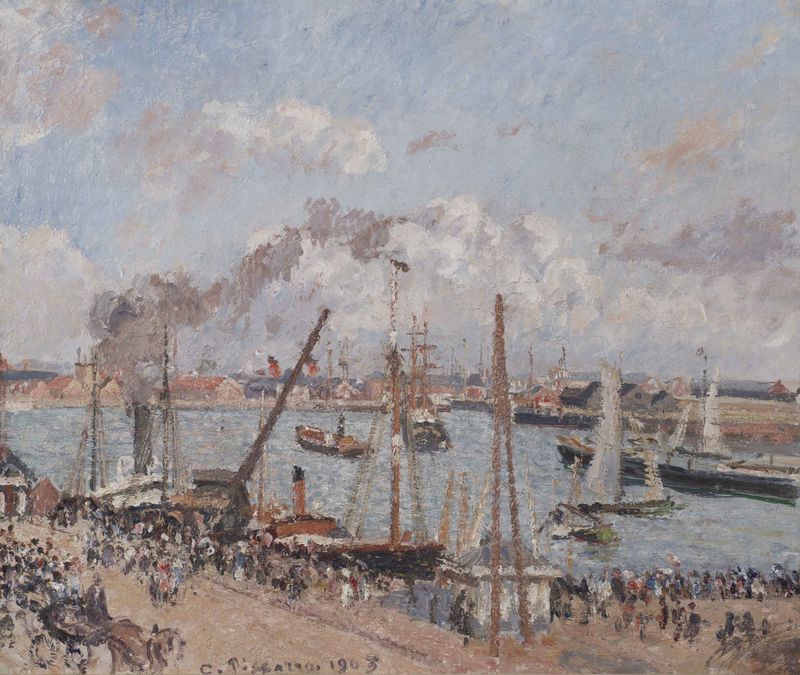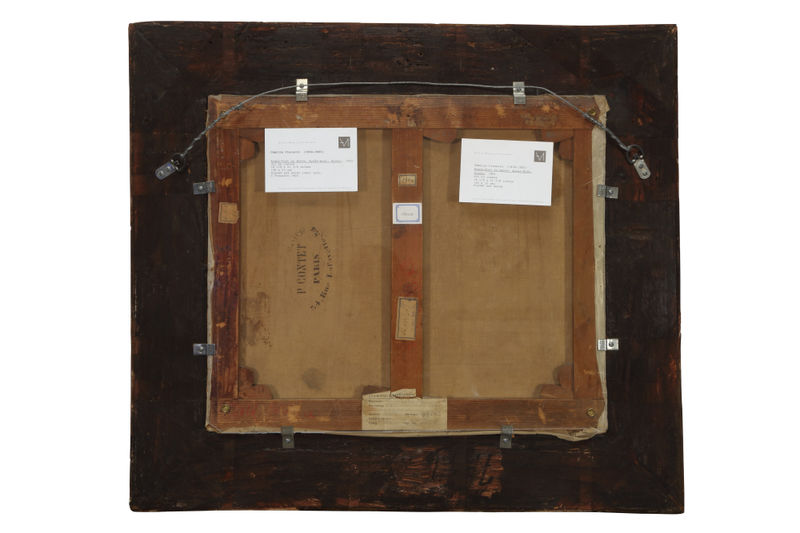Camille Pissarro
(French, 1830-1903)
L'Anse des Pilotes, après-midi, temps ensoleillé, Le Havre
1903
oil on canvas
47 x 55.5 cm (18½ x 21⅞ in.)
signed and dated ‘C. Pissarro. 1903’ (lower centre)
Ludovic-Rodolphe Pissarro, Paris (by descent from the artist, 1904)
Sally Falk, Mannheim
Paul Cassirer, Berlin (acquired from the above in April 1918)
Norbert Levy, Berlin (acquired from the above in November 1918)
Ludwig and Margaret Kainer, Berlin (by descent from the above in 1928)
Confiscated from the above by the Berlin tax office, as a consequence of Nazi persecution in 1935
Sale: Auktionshaus Union (Leo Spik), Berlin, 31 May 1935, lot 98
Günther Quandt, Berlin (acquired at the above sale)
Recovered by the Allies from Jesuiten-Schloss, Baden-Baden on 4 October 1945 and transferred to The Netherlands in 1946.
Returned to the Central Collecting Point, Baden-Baden in 1952, by which returned to Günther Quandt on 3 March 1953.
Galerie Neuendorf, Frankfurt am Main
Achim Moeller Fine Art, New York (on consignment from the above)
The Horowitz Family Collection, Atlanta (acquired from the above in 1994)
L. R. Pissarro and L. Venturi, Camille Pissarro: Son art–son oeuvre, Paris, 1939, vol. I, p. 262, no. 1307 (illustrated, vol. II, p. 254)
J. Pissarro and C. Durand-Ruel Snollaerts, Pissarro: Catalogue critique des peintures, Paris, 2005, vol. III, p. 910, no. 1505 (illustrated in colour)
Atlanta, High Museum of Art, Cézanne and the Modern: Masterpieces of European Art from the Pearlman Collection, 2014-2015
“Searching for a place suitable for my work has caused me endless toing and froing,” Camille Pissarro wrote in the summer of 1903. “It was only yesterday that I decided to put down roots in Le Havre; I’m staying at the Hôtel Continental, across from Le Havre jetty, the spot where all the ships go by” (quoted in J. Pissarro and C. Durand-Ruel Snollaerts, op. cit., 2005, p. 909). Settled into his hotel which was situated on the bustling harbour of the port town, Le Havre, in northern France, Pissarro set about painting an extensive series of twenty-four works over the course of July through September that capture the theatre of daily activity that played out in front of him. From the window of his room, he could look left, towards the Anse des Pilotes, the Pilots’ Cove, and the quai Southampton—the subject of the present work—and looking right, he had a view of the jetty and the semaphore used to guide ships into the port.
The Le Havre works are the culminating group of the monumental series of cityscapes that Pissarro executed in the final decade of his life. Beginning in 1893 with scenes of Paris, he continued over the years that followed to paint the capital, as well as a number of the urban centres of northern France—Rouen, Dieppe and finally, Le Havre. Le Havre occupied a poignant place within Pissarro’s own history: it was the first place in France that the artist set foot when he arrived from the island of St. Thomas in the Virgin Islands, the place of his birth. Returning to work there in 1903, in what would be the final year of his life, Pissarro had therefore come full circle. As a result, these Le Havre paintings are endowed with an autobiographical importance. As Richard R. Brettell and Joachim Pissarro have written, “Le Havre constitutes a moment of return, of speculative reflection on his past and, as Pissarro put it, upon his ‘destiny’” (The Impressionist and the City: Pissarro’s Series Paintings, exh. cat., Dallas Museum of Art, 1992, p. 196).
Up until this point, Pissarro had been, since the earliest days of Impressionism, the leading landscape painter of this movement. Over the course of his career he had immersed himself in the countryside of the Île-de-France, capturing the changing seasons, local inhabitants, and rural workers, as well as his own homes and family members. Unlike many of his Impressionist contemporaries, he had not painted scenes of life in cosmopolitan Paris, turning away from the cafés, dance halls, or new areas of Haussmann’s city.
It was initially by chance that Pissarro began painting cityscapes of Paris. In the spring of 1893, he remained in the city for an unexpectedly extended period. Looking for inspiration for his work, he began to paint from his hotel window. This marked the beginning of an intensive campaign that would continue for the rest of his career. By the end of his life, he had painted more urban views than any other Impressionist, attaining a position as one of the key chroniclers of fin-de-siècle France.
With these works, Pissarro embraced a serial method of working. As the present work and the rest of this 1903 Le Havre series demonstrate, he pictured subtly shifting motifs at different times of day, capturing not only the varying light and atmospheric conditions, but the gradual ebb and flow of life on the harbor, with scores of people meandering along the sidewalk, plumes of smoke unfolding from ships, and boats of all sizes leaving and entering, their sales hoisted or put away. As Joachim Pissarro has written, “Reprises, revisions, repetitions, variations—these are the strands running through the production of Pissarro’s final period. They help us to grasp the significance of his profound commitment to serial painting in his last decade” (ibid., p. 87). A total of eight works, including the present L’Anse des Pilotes, après-midi, temps ensoleillé, Le Havre, depict the same view (Pissarro and Snollaerts, nos. 1504-1511). Under a soft blue, cloud scudded sky, the present work depicts the harbour on a fine day. As a result, this is among the most vibrantly coloured canvases of the group, the grey waters of the Channel rendered in a palette of sparkling blues.
Pissarro was pleased with his summertime production in Le Havre. “I am very glad that I came here,” he wrote, “for one thing it is superb and has not been spoilt, and I have made several acquaintances here who like my painting and who will buy at one time or another” (quoted in ibid., p. 197). Not only was this series a commercial success, but these works gained in importance as time went by. Such was the intensity of Pissarro’s Le Havre campaign that these works became crucial records of the city at the turn of the century. Over the years that followed, the harbour was extensively renovated, thus this series stood as an important record of the original features. “I’m told [the pictures are] very important from the historical and documentary viewpoint!” he wrote excitedly. “The harbour is being demolished to make room for a bigger one, and once it has been demolished I’m told [they] will be unique” (quoted in J. Pissarro and C. Durand-Ruel Snollaerts, op. cit., 2005, pp. 912-913).
After Pissarro’s death, the present work passed to his son, Ludovic-Rodolphe Pissarro, before it entered the possession of the legendary German art dealer, Paul Cassirer. In 1918, Cassirer sold the painting to Norbert Levy, before passing by descent into the collection of his daughter and son-in-law, Ludwig and Margaret Kainer. Ludwig Kainer (1885-1967) was a German-Jewish graphic artist and designer. Born in Munich, he studied medicine before dedicating himself to art and design, falling in love with Impressionist art and the world of theatre and ballet. In 1923, Ludwig Kainer and Margaret Levy (1894-1968) married in Berlin. Their significant art collection included works Margaret had inherited from her father, Norbert Levy, alongside those Ludwig had acquired.
In 1932, the Kainers left for an extended break in Switzerland. Due to the Nazi rise to power in January 1933, however, they never returned to Germany. Following action by the Berlin tax office as part of anti-Semitic measures, the Kainer’s household contents and art collection, including this Pissarro, were forcibly sold through the Auktionshaus Union (Leo Spik), in May 1935 to pay the discriminatory “flight tax” imposed on any Jewish person who left the country. After the war, Ludwig and Margaret Kainer lived in Neuilly-sur-Seine near Paris.
L’Anse des Pilotes, après-midi, temps ensoleillé, Le Havre was later acquired by Gerald Horowitz, a former President of the Jewish Federation of Atlanta and former Chairman of the Board of The William Breman Jewish Home for senior care. A settlement agreement was agreed between the Horowitz family and the heirs of Ludwig and Margaret Kainer, resolving any dispute over ownership of the work.
Price:
POA
More artworks by Camille Pissarro ▶
You may also like:
Enquire Now
Fill in the form below and we will respond as soon as possible.
Make an offer
Fill in the form below and we will respond as soon as possible.



